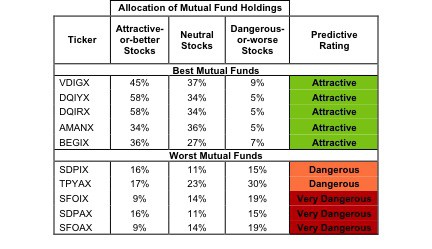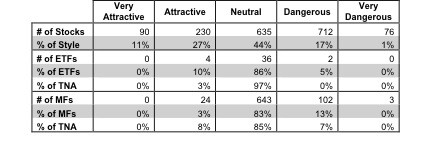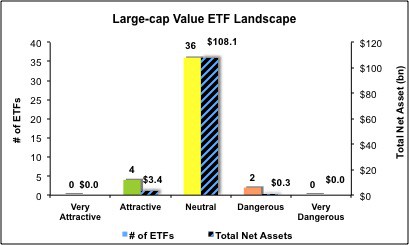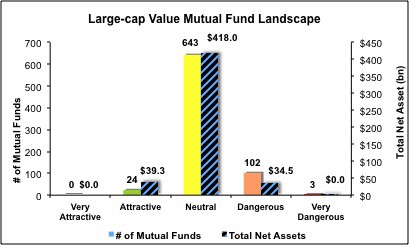The Large Cap Value style ranks second out of the twelve fund styles as detailed in my Style Rankings for ETFs and Mutual Funds report. It gets my Neutral rating, which is based on aggregation of ratings of 42 ETFs and 772 mutual funds in the Large Cap Value style as of July 11, 2013. Prior reports on the best & worst ETFs and mutual funds in every sector and style are here.
Figures 1 and 2 show the five best and worst ETFs and mutual funds in the style. Not all Large Cap Value style ETFs and mutual funds are created the same. The number of holdings varies widely (from 22 to 1410), which creates drastically different investment implications and ratings. The best ETFs and mutual funds allocate more value to Attractive-or-better-rated stocks than the worst, which allocate too much value to Neutral-or-worse-rated stocks.
To identify the best and avoid the worst ETFs and mutual funds within the Large Cap Value style, investors need a predictive rating based on (1) stocks ratings of the holdings and (2) the all-in expensesof each ETF and mutual fund. Investors need not rely on backward-looking ratings. My fund rating methodology is detailed here.
Investors seeking exposure to the Large Cap Value style should buy one of the Attractive-or-better rated ETFs or mutual funds from Figures 1 and 2.
Get my ratings on all ETFs and mutual funds in this style by searching for Large-cap Blend on my freemutual fund and ETF screener.
Figure 1: ETFs with the Best & Worst Ratings – Top 5
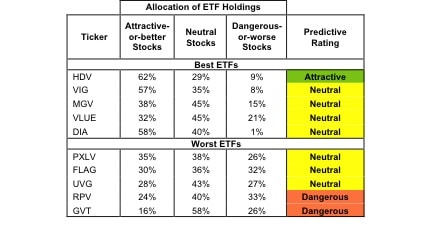 * Best ETFs exclude ETFs with TNAs less than $100 million for inadequate liquidity.
* Best ETFs exclude ETFs with TNAs less than $100 million for inadequate liquidity.
Sources: New Constructs, LLC and company filings
WisdomTree U.S. Dividend Growth Fund (DGRW), First Trust Capital Strength ETF (FTCS), and WisdomTree Earnings 500 Fund (EPS) are excluded from Figure 1 because their total net assets (TNA) are below $100 million and do not meet our liquidity standards.
Figure 2: Mutual Funds with the Best & Worst Ratings – Top 5
* Best mutual funds exclude funds with TNAs less than $100 million for inadequate liquidity.
Sources: New Constructs, LLC and company filings
Advisors Series Trust: Coldstream Dividend Growth Fund (CMDGX) is excluded from Figure 2 because its total net assets (TNA) are below $100 million and do not meet our liquidity standards.
iShares High Dividend ETF (HDV) is my top-rated Large Cap Value ETF and Vanguard Dividend Growth Fund (VDIGX) is my top-rated Large Cap Value mutual fund. Both earn my Attractive rating.
Columbia Concentrated Large Cap Value Strategy Fund (GVT) is my worst-rated Large Cap Value ETF and 360 Funds: Snow Capital Focused Value Fund (SFOAX) is my worst-rated Large Cap Value mutual fund. GVT earns my Dangerous rating and SFOAX earns my Very Dangerous rating.
Figure 3 shows that 320 out of the 1,743 stocks (over 38% of the market value) in Large Cap Value ETFs and mutual funds get an Attractive-or-better rating. However, only 4 out of 42 Large Cap Value ETFs (less than 3% of total net assets) and 24 out of 772 Large Cap Value mutual funds (less than 8% of total net assets) get an Attractive-or-better rating.
The takeaways are: mutual fund managers allocate too much capital to low-quality stocks and Large Cap Value ETFs hold poor quality stocks.
Figure 3: Large Cap Value Style Landscape For ETFs, Mutual Funds & Stocks
Sources: New Constructs, LLC and company filings
As detailed in “Low-Cost Funds Dupe Investors”, the fund industry offers many cheap funds but very few funds with high-quality stocks, or with what I call good portfolio management.
Investors need to tread carefully when considering Large Cap Value ETFs and mutual funds, as 2 ETFs and 105 mutual funds in the Large Cap Value style earn a Dangerous. Only 4 ETFs and 24 mutual funds in the Large Cap Value style allocate enough value to Attractive-or-better-rated stocks to earn an Attractive rating.
Target (TGT) is one of my favorite stocks held by Large Cap Value ETFs and mutual funds and earns my Attractive rating. TGT has a respectable return on invested capital (ROIC) of 9% and has grown revenue by 7% compounded annually for the past 15 years. Its valuation is the most compelling aspect of this stock. At ~$72.03/share, TGT has a free cash flow yield of 14% and a price to economic book value ratioof only 1.0. TGT’s high free cash flow yield shows that it is bringing in significant cash for investors, while its price to economic book value indicates that the market expects no profit growth in its future. TGT’s solid financial footing and cheap valuation make it a safe stock for investors.
NiSource Inc. (NI) is one of my least favorite stocks held by Large Cap Value ETFs and mutual funds and earns my Dangerous rating. Over the past decade, NI’s after tax profit (NOPAT) has decreased by 3% compounded annually and its revenues have decreased by 2% compounded annually. It has only one year of positive economic earnings in its past 13. One would expect as stagnant a company as NI to be fairly cheap, but instead its stock is priced for major growth. To justify its valuation of ~$29.89/share, NI would need to grow NOPAT by 8% compounded annually for 12 years. Given its track record, betting on such impressive growth from NI is a risky proposition.
Figures 4 and 5 show the rating landscape of all Large Cap Value ETFs and mutual funds.
My Style Rankings for ETFs and Mutual Funds report ranks all styles and highlights those that offer the best investments.
Figure 4: Separating the Best ETFs From the Worst Funds
Sources: New Constructs, LLC and company filings
Figure 5: Separating the Best Mutual Funds From the Worst Funds
Sources: New Constructs, LLC and company filings
Review my full list of ratings and rankings along with reports on all 42 ETFs and 772 mutual funds in the Large Cap Value style.
Sam McBride and André Rouillard contributed to this report.
Disclosure: David Trainer, Sam McBride and André Rouillard receive no compensation to write about any specific stock, sector, style or theme.

